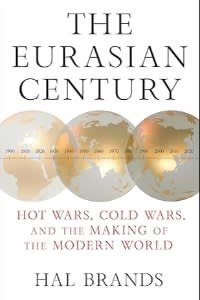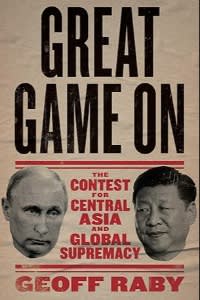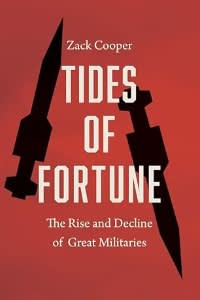Amid the usual bluster, the most remarkable lines in Donald Trump’s second inaugural address were about geography. “The United States will once again consider itself a growing nation,” the president said back in January. America would now be a country that “expands our territory . . . and carries our flag into new and beautiful horizons”.
Many did not take seriously Trump’s ruminating about retaking the Panama Canal or annexing Canada or Greenland. Yet the longer he has done so, the clearer it has become that his instincts involve an odd mixture of geographic expansion and isolationism. His return to the White House heralds not just a turbulent moment in business and geopolitics, but also the end of hopes for a more borderless world, and a return to concerns about territorial boundaries and economic control.
Three new books offer a useful guide to these developments, each grappling with a revisiting of earlier eras in which the fundamentals of location shaped global affairs. All three underline the fact that Trump’s musings are part of a larger contest. The risk of autocratic dominance of Eurasia — the supercontinent that stretches from the Atlantic to the Pacific — is clearly rising in a moment of renewed co-operation between China and Russia, while an increasingly autocratic US lacks a clear strategy to respond.

In The Eurasian Century, American historian Hal Brands makes a bold argument about the central place of the Eurasian landmass during the 20th century’s geopolitical battles, while suggesting a similar contest is now under way in the 21st.
Former Australian ambassador to China Geoff Raby has a narrower lens in Great Game On, examining what he calls “Core Eurasia” and the changing balance between Russian and Chinese power.
Finally comes Tides of Fortune by Zack Cooper, a respected think-tank researcher in Washington. Drawing on historical case studies, Cooper builds a compelling theory of how great powers behave as they rise and fall, with lessons for the current US-China contest.
Brands uses geography as his main lens. “Eurasia is the fulcrum of world order,” he writes. “A country or group of countries that dominates its vital regions would have unmatched resources, wealth, and global reach.”
His book provides a brisk 20th-century military history interwoven with intellectual portraits of the founders of what we now know as geopolitics — many of whom turn up in Raby and Cooper’s books too.
One is Sir Halford Mackinder, a famed British geographer whose “heartland theory”, first developed in a lecture in 1904, challenged the naval dominance that underpinned Britain’s global power. Instead, he focused on land control in Eurasia, notably the “heartland” of eastern Europe. Elsewhere, Brands discusses Alfred Thayer Mahan, a late 19th-century American maritime strategist who pushed his nation to build a powerful global navy. Also influential is Nicholas Spykman, a Dutch-American political scientist whose “rimland” theory, developed in the early 1940s in response to Mackinder, argued that global power lay in controlling coastal Eurasia, from western Europe to south-east and east Asia.
Brands also introduces, albeit more briefly, a series of “authoritarian” strategists with similar geographic approaches, including Alexander Dugin, a contemporary Russian ultranationalist ideologue and occasional adviser to President Vladimir Putin.
The result is a brisk and engagingly written work. In Brands’ telling, both world wars and the cold war that followed represented battles for Eurasia between democratic and autocratic powers. A similar battle is now under way, in which “an autocratic China, or an autocratic axis” might conceivably gain “primacy within that landmass and its adjoining oceans today”.
Raby’s Great Game On offers a more focused examination of geopolitical competition in the five states of Central Asia — Kazakhstan, Kyrgyzstan, Tajikistan, Turkmenistan and Uzbekistan — along with Afghanistan and Mongolia.

As its title suggests, Raby’s book draws a parallel with the 19th-century “Great Game” that pitted Britain against Russia, albeit with Moscow and Beijing now as primary competitors. Drawing on both Mackinder and Spykman, he argues that Beijing holds a decisive advantage, with far-reaching implications for the US and Europe.
This detailed and thoughtful book is both challenging to much western conventional wisdom and sympathetic to Beijing’s sense of its own vulnerabilities. For millennia, Raby writes, China’s leaders have seen themselves as “beset by enemies from across the sweeping Eurasian landmass”. This trauma produced a preoccupation with “frontier stability”, both in the restive Xinjiang borderlands and the broader region.
China has moved methodically to resolve this strategic dilemma, combining harsh internal security in Xinjiang with its massive Belt and Road Initiative infrastructure investments to push Chinese influence through central Asia and towards Europe.
This has proved almost entirely successful, Raby suggests, allowing China to create a new zone of influence in central Eurasia, which he dubs “Sinostan”. The main casualty is Russian rather than western power. Moscow’s full-scale invasion of Ukraine heightened anxieties about its intentions in Central Asian nations, driving them further into Beijing’s orbit.
Raby’s benevolent view of China contrasts with Brands and Cooper, both of whom hunt through history for advice to give the modern US as it grapples with rising Chinese power.
Both ambitious and convincing, Cooper’s Tides of History draws lessons from the historical trajectories of great powers, examining the rise of the US in the 19th century, for instance, and Russia during its rapid fall after the cold war.

His four-stage model of great power behaviour suggests distinct behaviours and strategies. What matters is not just a nation’s actual power but also its own deluded self-perceptions, which often lag reality.
Great powers and their militaries shift “their defense objectives, strategies, and investments in predictable ways” as their power grows and ebbs. “The US and Chinese militaries are once again following these paths today.”
To take one intriguing example, a rising US in the late 1900s adopted naval tactics that are remarkably similar to China’s today. Rather than challenge the more powerful British, the US focused on guerrilla tactics to protect its home shoreline and keep its stronger rival at bay — just as China has done over recent decades as it challenges the modern US navy.
Rather than Mackinder and Spykman, it is Mahan who turns up most often in Cooper’s account, as the naval theorist made the case for American maritime power, while pushing to finish the Panama Canal, whose completion in 1914 allowed the US to move its fleet into the Pacific.
Today’s China, as it progresses through Cooper’s four stages, has shifted away from guerrilla tactics and begun to project power globally. The US, as the relatively weakening power, Cooper suggests, must now adapt, shifting to a much more defensive approach, for instance using new technologies such as drones to keep China at bay.
The three books are different in style: Brands writes with sweep and confidence; Raby is more focused and detailed; Cooper is precise and academic in tone while setting out his theory. Yet each shows common themes that can help to understand what Brands dubs the “second Eurasian century”.
Geography plays a pivotal role in all three, but so does the formation of coalitions. Back in the 1940s, Spykman warned that a Eurasia under autocratic control would pose an unacceptable threat to American security. Both Cooper and Brands have similar fears today, given a new autocratic Russian-Chinese axis.
Brands argues that the US must adopt much the same pragmatic approach as in the cold war. Countering Beijing, he contends, requires a coalition including authoritarian regimes from Turkey to Saudi Arabia and Vietnam. If not, the Russia-China axis will push back American influence and reduce Europe “to a democratic toehold in a Sino-centric supercontinent”.
Attitudes to China provide one clear distinction between the three accounts. Brands and Cooper are anxious about Beijing’s rise. Raby adopts a less critical (and at times notably uncritical) stance. Rather than counterbalancing China, the US in the end should strike a “grand bargain” that recognises “the legitimacy of China’s position in the world order”.
Raby is also less worried about a Russian-Chinese axis, predicting that Moscow will chafe against Beijing’s sway, with stark consequences for European leaders. “Europe is confronted by a historic choice,” he suggests. “It can let Russia drift closer and closer to China and become integrated in its tributary system, or it can seek to do a ‘reverse Kissinger’ (that is, using Russia to balance China) and re-Europeanise Russia.”
There is much to contest about this analysis. It is hard presently to see many obvious signs of the tensions between Moscow and Beijing that Raby predicts. European leaders, ever more anxious about having to fight a war against Putin’s Russia, are unlikely to look kindly on his talk of a rapprochement.
Speculation about such a “reverse Kissinger” gambit has been rife of late in reference to Trump’s outreach to Putin. This underlines another common theme of all three books, namely the central role the US must play — and thus the importance of Trump’s next moves. Historically, as Brands puts it, “no Eurasian balance of power was possible without America”, given its unique power “at both ends” of the supercontinent. Yet while Trump has signalled a clear break with Europe, his approach to east Asia remains ambiguous.
Until recently, Washington was bent on defending Taiwan, viewing the island’s fall as a step in Chinese domination of the Pacific. Trump’s clear lack of interest in Taiwan, in common with his focus on Panama and Greenland, indicates it is now conceivable that he could be tempted by the kind of grand bargain Raby suggests.
Rather than prioritising China, this would see the US retrenching to the western hemisphere in a new world of spheres of influence. This idea of America as an isolated “garrison state” found little favour among Trump’s predecessors. President Franklin D Roosevelt once argued that America could not survive as an “oasis of liberty surrounded by a cruel desert of dictatorship”. Trump might now put that assertion to the test.
The Eurasian Century: Hot Wars, Cold Wars, and the Making of the Modern World by Hal Brands, WW Norton £22.99/$29.99, 320 pages
Great Game On: The Contest for Central Asia and Global Supremacy by Geoff Raby, Melbourne University Publishing £24.99, 240 pages
Tides of Fortune: The Rise and Decline of Great Militaries by Zack Cooper, Yale £25/$38, 264 pages
James Crabtree is author of the forthcoming book ‘The Perimeter: The Inside Story of the Struggle to Save American Primacy in the Pacific — and the World’
Join our online book group on Facebook at FT Books Café and follow FT Weekend on Instagram and X

